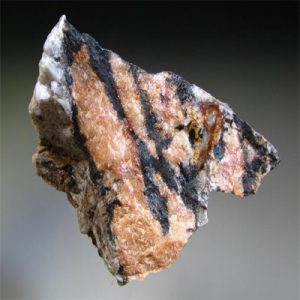Lithiophilite (incl.)
Lithiophilite is a member of the Triphylite Group of minerals that also includes Purpurite and Triphylite. The Triphylite Group is a group of anhydrous phosphate minerals. The name Lithiophilite, which is also incorrectly spelled Lithiophilite, can be translated from the Greek as lithium friend for its lithium content. Although Lithiophilite is scarce and generally does not form good crystals, it can be found as inclusions in Quartz. Quartz gems, usually cabochons, with thin, flat slivers of brown Lithiophilite are rare, unusual, attractive and very collectible. These flat slivers of Lithiophilite are often iridescent.Locations for finding Lithiophilite: In the USA, from Branchville, Fairfield County, and in the Strickland quarry, Portland, Middlesex County, Connecticut; at several places in Maine, as Buckfield and Norway, Oxford County, and Poland, Androscoggin County; in the Custer Mountain mine, and elsewhere in Custer County, South Dakota; good crystals from the Foote mine, near Kings Mountain, Cleveland County, North Carolina; in the Harding mine, Dixon, Taos County, New Mexico; in the White Picacho district, Yavapai County, Arizona; at several mines in the Pala district, San Diego County, California. In Canada, from the Tanco mine, Bernic Lake, Manitoba. From the Mangualde pegmatite, near Mesquitela, and the Bendada pegmatite, near Guarda, Portugal. In the Viitaniemi pegmatite, near Eräjärvi, Finland. Large masses in the Blesberg mine, Noumas pegmatite, Northern Cape Province, South Africa. From Karibib, Namibia. In the Buranga pegmatite, near Gatumba, Rwanda. At Wodgina, Western Australia. Several other localities are known.
| Category: | Phosphate minerals |
| Chemical Formula: | LiMn2+PO4 |
| Lithium Manganese Phosphate | |
| Molecular Weight: | 156.85 gm |
| Composition: | Lithium | 4.43 % | Li | 9.53 % | Li2O |
| Manganese | 35.03 % | Mn | 45.23 % | MnO | |
| Phosphorus | 19.75 % | P | 45.25 % | P2O5 | |
| Oxygen | 40.80 % | O | |||
| 100.00 % | 100.00 % | = TOTAL OXIDE |
| Crystallography: | Orthorhombic – Dipyramidal |
| Crystal Habit: | Sharply terminated crystals may show {010}, {011}, {021}, {111}, with {100}, {110}, {130}, {140}; commonly as crudely anhedral crystals and cleavages, to 1 m. |
| Twinning: | Rare contact twins on {130} |
| Cleavage: | Perfect on {100}, good on {010} |
| Fracture: | Irregular/Uneven, Sub-Conchoidal |
| Tenacity: | Brittle |
| Moh’s Hardness: | 4.0 |
| Density: | 3.29 – 3.50 (g/cm3) |
| Luminescence: | None |
| Radioactivity: | Not Radioactive |
| Color: | Clove-brown, yellowish brown, honey-yellow, salmon-pink, blue-gray, gray, typically surficially black from alteration; colorless to pale yellow or pink in transmitted light. Low Fe mineral is pale pinkish brown to orange. Maybe black due to oxidation and staining. |
| Transparency: | Transparent to translucent |
| Luster: | Sub-vitreous to resinous, greasy |
| Refractive Index: | 1.663 – 1.691 Biaxial ( + ) |
| Birefringence: | 0.008 – 0.010 |
| Dispersion: | Strong; r < v |
| Pleochroism: | Weak; X = deep pink, Y = pale greenish yellow, Z = pale pink |


